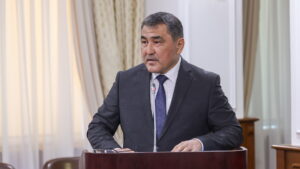ASTANA – The Kazakh government adopted the draft Concept for developing a water resources management system for 2024-2030 at a Jan. 30 meeting chaired by Prime Minister Alikhan Smailov, reported the Prime Minister’s press service.

Photo credit : gettyimages.com
Ensuring Kazakhstan’s water security
According to Minister of Water Resources and Irrigation Nurzhan Nurzhigitov, the document envisages the construction of 20 new reservoirs, the reconstruction of 15 existing ones, and the modernization of over 14,000 kilometers of irrigation canals and hydraulic structures.

Nurzhan Nurzhigitov. Photo credit: primeminister.kz
The concept will reduce unproductive water losses during transportation from 50% to 25% while increasing available water resources by 2.4 cubic kilometers, thereby expanding the irrigated land area to 2.5 million hectares by 2030.
Providing support measures
To encourage farmers to use water-saving technologies, the share of subsidizing costs for creating irrigation systems and procuring drip and sprinkler irrigation equipment will grow from 50% to 80%.
With this, the land area irrigated with water-saving technologies will increase to 1.3 million hectares, saving about 2.1 cubic kilometers of water and augmenting agricultural yields.
Creating information and analytical center for water resources
The development of the hydro.gov.kz digital platform, designed to serve as a unified water cadastre displaying water bodies, hydraulic structures, water basins, and gauging stations, will be put into commercial operation in the current year’s third quarter.
Nurzhigitov noted that the Concept also allows for digitizing over 3,500 kilometers of water utilities and automating water accounting for irrigation systems.
Addressing deficiency
The Prime Minister necessitated the construction and reconstruction of water infrastructure, mentioning that the Satpayev Canal, the main water artery of central Kazakhstan and the capital, has only 30% efficiency of pumping stations.
“The Big Almaty Canal has not been repaired for 40 years from the date of commissioning,” he said. “Most of the main and inter-farm canals in the Turkistan, Kyzylorda and Zhambyl regions are in a worn-out condition, which resulted in 40% water losses.”
Stimulating water conservation
Smailov stressed the need to accelerate the adoption of water-saving systems and underscored the importance of domestic production to make these technologies more accessible to farmers.
He prioritized scientific research to optimize water resource utilization, including exploring options for the equitable distribution of resources from the Irtysh River.
Resolving transboundary water usage
Smailov focused on resolving transboundary water usage issues through negotiation processes. The Concept provides for signing agreements between Kazakhstan, Uzbekistan and China on joint management, usage and distribution of water in transboundary water bodies to develop interstate water relations.
Additionally, the ministry is working on a draft agreement on water and energy cooperation between Central Asian countries.
The Prime Minister instructed regional authorities to develop roadmaps to restore and digitize irrigation systems, alongside conducting comprehensive assessments of municipal hydraulic structures.
Kazakhstan has recently joined the United Nations Watercourses Convention, which ensures the fair distribution of water in transboundary rivers.


